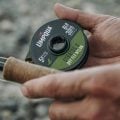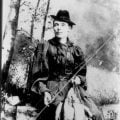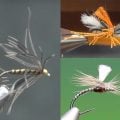How to Tie the Early Black Stonefly Nymph
Producer: tightlinevideo
Here in the northeastern United States, early black stonefly activity usually begins in late winter. For many fly fishers, it’s really the first dependable hatch of the year. Early black stonefly nymphs tend to wiggle as they struggle to get to the bank to hatch. The movement draws the attention of hungry trout that have spent the winter sustaining themselves on much smaller offerings. This spindly-looking little imitation has proven itself to be extremely effective over the last eight years by mimicking this motion. Although it’s body shape and color are important, I believe it’s the way its long, thin antennae and tails move that really sell it.
The fly starts with a Dai-Riki #280 in size 18 or something similar. After getting the hook firmly secured in the jaws of your tying vise, load a bobbin with a spool of black UTC 70 Denier. Get the thread started on the hook shank and, after taking a few wraps rearward, snip off the excess tag. Then advance your thread forward to just behind the hook eye.
For the antennae and legs, Montana Fly Company’s Centipede Legs in the “mini” size work exceptionally well. Snip a single strand free from the hank then fold it roughly in half to form a small loop. Place the loop on top of the hook shank so it extends about a half inch in front of the hook eye. With a pinch wrap, secure the rubber legs to the top of the shank and take thread wraps rearward, all the way to about the hook barb. Pressure from the wraps should make the rubber leg tails splay nicely. End with your tying thread 2/3 of the way up the hook shank.
Black or dark brown micro-sized stretch tubing is used to form the segmented body of the fly. A 10” length is enough to make numerous flies. Place one end of the material against the near side of the hook and take thread wraps to secure it. Bind the tubing down, all the way to the base of the tail. Start taking touching to slightly overlapping wraps with the tubing behind your tying thread. When you get 2/3 of the way up the hook shank, anchor the tubing with nice tight thread wraps, and snip the excess off close.
Chocolate brown or black pheasant tail fibers are used to form the fly’s wing case. Strip 8-10 fibers free from the stem and snip off the curly ends. Flip the fibers around and snip the tips off as well. Lay the snipped-off ends on top of the hook shank and take thread wraps to secure them. You want the wing case to be somewhere between a third and a half of a hook shank in length. End with your tying thread about halfway up to the hook eye.
Dark brown Australian Possum is used to form the thorax of the fly. Pull just a small wisp free from the packet. Use the dubbing to create a slender inch-and-a-half long noodle on your tying thread. Start taking wraps with the noodle to build up a bulbous little thorax on the fly, ending with bare thread at the back edge of the hook eye. Bring the pheasant tail fibers forward to in front of the eye, then anchor them with tight wraps of tying thread immediately behind the eye. Pull the forward-pointing fibers up and snip them off as close as possible. Sweep the rubber leg material back and take a few thread wraps behind the eye.
Reach for your whip finish tool and use it to complete a 4-5 turn whip finish, seat the knot well and snip or cut your tying thread free. Snip the midpoint of the front loop to produce two antennae then trim the tails to about a full hook in length. Do the same for the antennae. The fly should now look something like this. Reach for some UV cure resin or head cement and apply it to the pheasant tail wing case to toughen it up and add a little bit of shine.
The micro rubber legs aren’t very durable, especially when exposed to sun and heat, but anything heavier doesn’t seem to move as well underwater.
I like to fish this fly in deeper runs where trout tend to hold during the winter months. Since it has no weight, I fish it behind a heavily weighted nymph along with some extra split shot if necessary. Cold hands are a small price to pay for a cure for the wintertime blues.
How to Tie the Dynamite Balanced Leech
How to Tie the Eggstasy Egg











